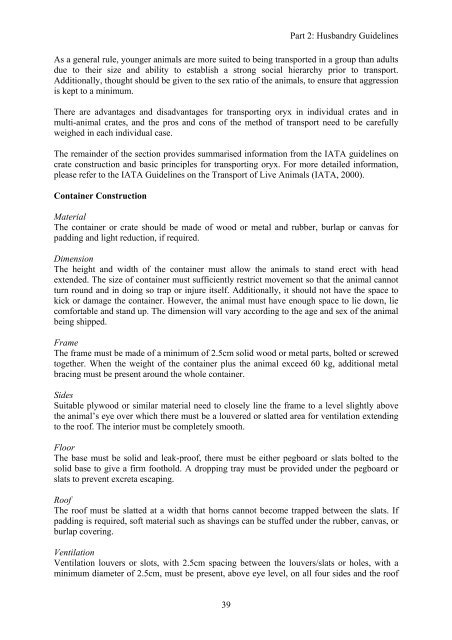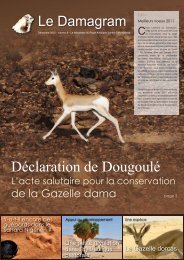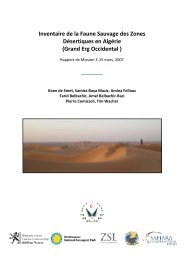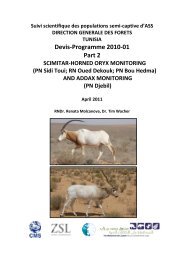The Biology, Husbandry and Conservation Scimitar-horned Oryx ...
The Biology, Husbandry and Conservation Scimitar-horned Oryx ...
The Biology, Husbandry and Conservation Scimitar-horned Oryx ...
You also want an ePaper? Increase the reach of your titles
YUMPU automatically turns print PDFs into web optimized ePapers that Google loves.
39<br />
Part 2: <strong>Husb<strong>and</strong>ry</strong> Guidelines<br />
As a general rule, younger animals are more suited to being transported in a group than adults<br />
due to their size <strong>and</strong> ability to establish a strong social hierarchy prior to transport.<br />
Additionally, thought should be given to the sex ratio of the animals, to ensure that aggression<br />
is kept to a minimum.<br />
<strong>The</strong>re are advantages <strong>and</strong> disadvantages for transporting oryx in individual crates <strong>and</strong> in<br />
multi-animal crates, <strong>and</strong> the pros <strong>and</strong> cons of the method of transport need to be carefully<br />
weighed in each individual case.<br />
<strong>The</strong> remainder of the section provides summarised information from the IATA guidelines on<br />
crate construction <strong>and</strong> basic principles for transporting oryx. For more detailed information,<br />
please refer to the IATA Guidelines on the Transport of Live Animals (IATA, 2000).<br />
Container Construction<br />
Material<br />
<strong>The</strong> container or crate should be made of wood or metal <strong>and</strong> rubber, burlap or canvas for<br />
padding <strong>and</strong> light reduction, if required.<br />
Dimension<br />
<strong>The</strong> height <strong>and</strong> width of the container must allow the animals to st<strong>and</strong> erect with head<br />
extended. <strong>The</strong> size of container must sufficiently restrict movement so that the animal cannot<br />
turn round <strong>and</strong> in doing so trap or injure itself. Additionally, it should not have the space to<br />
kick or damage the container. However, the animal must have enough space to lie down, lie<br />
comfortable <strong>and</strong> st<strong>and</strong> up. <strong>The</strong> dimension will vary according to the age <strong>and</strong> sex of the animal<br />
being shipped.<br />
Frame<br />
<strong>The</strong> frame must be made of a minimum of 2.5cm solid wood or metal parts, bolted or screwed<br />
together. When the weight of the container plus the animal exceed 60 kg, additional metal<br />
bracing must be present around the whole container.<br />
Sides<br />
Suitable plywood or similar material need to closely line the frame to a level slightly above<br />
the animal’s eye over which there must be a louvered or slatted area for ventilation extending<br />
to the roof. <strong>The</strong> interior must be completely smooth.<br />
Floor<br />
<strong>The</strong> base must be solid <strong>and</strong> leak-proof, there must be either pegboard or slats bolted to the<br />
solid base to give a firm foothold. A dropping tray must be provided under the pegboard or<br />
slats to prevent excreta escaping.<br />
Roof<br />
<strong>The</strong> roof must be slatted at a width that horns cannot become trapped between the slats. If<br />
padding is required, soft material such as shavings can be stuffed under the rubber, canvas, or<br />
burlap covering.<br />
Ventilation<br />
Ventilation louvers or slots, with 2.5cm spacing between the louvers/slats or holes, with a<br />
minimum diameter of 2.5cm, must be present, above eye level, on all four sides <strong>and</strong> the roof





